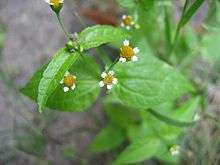Galinsoga parviflora
| Galinsoga parviflora | |
|---|---|
 | |
| Scientific classification | |
| Kingdom: | Plantae |
| (unranked): | Angiosperms |
| (unranked): | Eudicots |
| (unranked): | Asterids |
| Order: | Asterales |
| Family: | Asteraceae |
| Genus: | Galinsoga |
| Species: | G. parviflora |
| Binomial name | |
| Galinsoga parviflora Cav. 1796 | |
| Synonyms[1][2][3] | |
|
Synonymy
| |
Galinsoga parviflora[4] is an herbaceous plant in the Asteraceae (daisy) family. It has several common names including guasca (Colombia), mielcilla (Costa Rica), galinsoga (NZ), gallant soldiers .(UK)[5]/(US),[6]
History
Galinsoga parviflora was brought from Peru to Kew Gardens in 1796, and later escaped to the wild in Great Britain and Ireland, being temporarily known as the 'Kew Weed'.[7] The plant is named after the Spanish botanist Ignacio Mariano Martinez de Galinsoga. The species name 'parviflora' translates to 'having small flowers'.[8] In Britain, its name Galinsoga is sometimes popularly rendered as "gallant soldiers", and then sometimes altered to "soldiers of the Queen". In Malawi, where the plant is naturalised, it is known as 'Mwamuna aligone' which translates to 'My husband is sleeping'.[7]
Uses
In Colombia it is used as a spice herb in the soup Ajiaco.[1] It can also be used as an ingredient in leaf salads.
Description
Galinsoga parviflora grows to a height of 75 cm (30 inches). It is a branched herb with opposite stalked leaves, toothed at the margins. The flowers are in small heads. The 3-8 white ray-florets are about 1 mm (0.4 inches) long and 3-lobed. The central disc florets are yellow and tubular.[9][10]
Distribution
The species is native to South America, however it is widely naturalised in other countries.[11][12] There are a few records of G. parviflora and G. ciliata in Northern Ireland.[13] It has been naturalized elsewhere, including North America and Australia.[14][10][15][16]
References
- 1 2 B & T World Seeds, Tridax parviflora (Galinsoga parviflora) in Profile includes photo plus recipe for soup containing this plant as an ingredient
- ↑ Tropicos, Galinsoga parviflora Cav.
- ↑ The Plant List, Galinsoga parviflora Cav.
- ↑ Royal New Zealand Institute of Horticulture - Horticulture Pages - Weeds - Index of names
- ↑ "BSBI List 2007". Botanical Society of Britain and Ireland. Archived from the original (xls) on 2015-01-25. Retrieved 2014-10-17.
- ↑ "Galinsoga parviflora". Natural Resources Conservation Service PLANTS Database. USDA. Retrieved 19 January 2016.
- 1 2 Lovett., Jones, Gareth; )., Gibbons, Bob (1949-. Flora Britannica : supported by common ground. Chatto & Windus. ISBN 1856193772. OCLC 805221553.
- ↑ Sue., Gordon, (2007-01-01). Plant names explained : botanical terms and their meaning. David & Charles. ISBN 9780715321881. OCLC 471017850.
- ↑ Clapham, A.R., Tutin, T.G. and Warburg, E.F. 1968 Excursion Flora of the British Isles. Cambridge University Press. ISBN 0-521-04656-4
- 1 2 Flora of China, Galinsoga parviflora Cavanilles, 1795. 牛膝菊 niu xi ju
- ↑ "Galinsoga parviflora (Gallant-soldier) | Online Atlas of the British and Irish Flora". www.brc.ac.uk. Retrieved 2017-05-16.
- ↑ http://www.cabi.org/isc/datasheet/25299
- ↑ Hackney, P. (Ed.) 1992. Stewart & Corry's Flora of the North-east of Ireland. Third Edition. ISBN 0-85389-446-9
- ↑ Flora of North America, Galinsoga parviflora Cavanilles, 1795.
- ↑ Atlas of Living Australia
- ↑ Altervista Flora Italiana, Galinsoga parviflora Cav. includes photos, European distribution map
External links
- Dressler, S.; Schmidt, M. & Zizka, G. (2014). "Galinsoga parviflora". African plants – a Photo Guide. Frankfurt/Main: Forschungsinstitut Senckenberg.
- Photo of herbarium specimen at Missouri Botanical Garden, collected in Brazil in 1987
- Photo of herbarium specimen at Missouri Botanical Garden, collected in Dominican Republic in 2006
| Wikimedia Commons has media related to Galinsoga parviflora. |